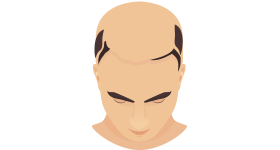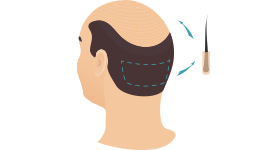
Hair Transplantation
Hair transplant allows both men and women to get rid of hair loss and restore natural hair growth and density. This minimally invasive surgical procedure is effective and comfortable; it does not require a long rehabilitation period. It is used to restore hair on the head, in the area of eyebrows, beards and even sideburns.
The procedure is carried out according to the most modern methods. The most famous and effective are the FUE (Follicular Unit Extraction) method hair transplant and the DHI method . The transplanted hair has a natural look and the patients have no scars and unnatural hair plugs.
In recent years Turkey, especially Istanbul, has become a global leader in the field of hair transplant surgery. Thanks to highly experienced surgeons, state-of-the-art clinics, and successful results, thousands of patients from the UK, Europe, the USA, and the Middle East choose Istanbul every year. The goal is always the same: to achieve natural hair density, a lifetime solution to baldness, and a boost in confidence.
A hair transplant in Turkey is tailored to each patient. Before the operation, specialists analyze hair type, donor capacity, and the degree of hair loss to determine the best technique (such as Sapphire FUE for high-density results or DHI hair transplant for precise implantation). Advanced technologies ensure a faster recovery process, minimal pain, and strong graft survival rates.
Patients can return to their daily routine shortly after surgery, with visible improvements beginning within a few months. Full and permanent results are typically achieved within 9–12 months. This makes the procedure not only an aesthetic investment but also a long-term transformation for those suffering from hair thinning, androgenetic alopecia, or receding hairlines.
If you are considering restoring your hairline or improving hair volume, a modern hair transplant procedure can give you long-lasting, natural results with no obvious signs of surgery — just stronger confidence and a younger look.
Hair Transplant Process
the main stages of the procedure
Before the Operation

Before starting the hair transplant operation at hairpol, every patient goes through a preparation stage. It usually consists of a consultation and preliminary preparation.
Consultation
Preparation for hair transplant surgery begins with a consultation at the Hairpol clinic. To obtain complete information about the state of the patient’s health, the doctor conducts not only an external examination, but also performs all the necessary tests. As a rule, before the transplant procedure, the patient takes a blood test in clinic.
At the consultation, the surgeon can identify patient’s hair loss stage, the condition of nape donor area and number of the grafts to be transplanted. Based on all the obtained data, the doctor selects an the effective hair transplant method. Also, in preparation for a hair transplant, the doctor provides recommendations that the patient must follow within the time frame established before the surgery.
During the first visit to the Hairpol clinic, the doctor will necessarily examine not only the area for future transplantation, but also the donor area. Before starting the operation, it is important to assess the amount of donor material and the possibility of extracting it. After making a diagnosis and determining the number of grafts to be transplanted, the doctor begins to form a new hairline.
Also, at the first consultation, the patient is provided with a preliminary estimate of future costs. It is calculated depending on the chosen technique of the transplant, the number of transplanted grafts (hair follicles) and additional procedures (if necessary).
For patients living abroad, wishing to get treatment for hair loss at the Harpol clinic, a remote consultation service is provided. In this case, the patient will send newest photos of the baldness zones so that the doctor can determine the degree of baldness and choose the right treatment. It should be remembered that this form of consultation is considered preliminary and estimated. Only a personal consultation is required for the final diagnosis and selection of a hair transplant method.
Preparation
After the doctor sets the date for the operation, the preparation stage begins. As a rule, the schedule of operations in the clinic is drawn up several months in advance. Before surgery, doctor will recommend limiting or excluding certain foods and medications. Also, the patient should inform the doctor about the presence of skin diseases, if any. The doctor always makes recommendations in advance, including for further rehabilitation, which can often include taking antibiotics and medications to relieve possible pain.
The patient should refrain from smoking and drinking alcohol about a week before the operation. The doctor may advise you to stop taking any medications that may adversely affect the course of the operation. Also, in accordance with the instructions of the doctor, it is necessary to adjust the usual diet or intake of vitamins.
A few days before the transplant, it is recommended to rest and sleep more, to refuse to perform active physical exercises.
On the day of surgery, the patient needs to wash hair and take a shower. As a rule, patients can have breakfast on the day of the operation in the usual way. 2 hours before the start of the operation, fluid and food intake must be stopped. When choosing clothes, one should give preference to one that is not removed over the head, which will minimize friction and discomfort for the scalp when using bandaging. The clothing itself should be comfortable.
Operation

This is the beginning of the hair transplant process. The operation is performed under local anesthesia or sedation in a comfortable environment and consists of two main stages
Grafts Extraction
After the assistants treat the donor area with antiseptics, the doctor will begin extracting the grafts. Hair in the back of the head and on the temples, as a rule, does not loss in male pattern baldness. Therefore, they become the main material for transplantation. It is not the hair shafts that are transplanted to a new place from the donor zone, but their follicles, in other words, the roots that later produce hair growth. They are located in the scalp at a depth of 3-4 mm.
The technique of extracting the follicles is determined by the method of the operation. With the FUE method, individual follicular units are extracted one by one without incisions and sutures. This method is considered to be gentler and low traumatic. After hair transplantation using the FUE method or its sub types, there are no scars and visible traces of the surgery, and healing is faster. Donor material is usually extracted from the patient’s temporal or occipital area. If these areas cannot be used, the doctor extracts the follicles from the beard or chest.
Next, the extracted grafts are sorted using micro tweezers and prepared for the next stage of transplantation. Sometimes the grafts are split into separate hairs. This is necessary for transplanting them to the front of the head, in the hairline zone.
Hair transplantation
The next stage of the operation is the hair transplant itself. The doctor places the follicles in the balding area. Usually, grafts are implanted into the skin using surgical micro tweezers into pre-formed canals. These channels are formed in advance with a special tool, a micro blade. With this tool, the doctor makes a puncture between the existing hairs at the same angle at which natural hair grows. This helps to achieve the most natural result. The number of channels depends on the number of grafts. On average, a doctor makes about 2-3 thousand micro punctures. Then the grafts are transplanted manually using micro tweezers. There is another transplant method using the Choi instrument. With this method, hair transplant is performed in one touch without preliminary micro punctures.
The main task of the operation is not to recreate the lost amount of hair with mathematical precision, but to create a natural looking and sufficient volume of hair. If the resource of the donor zone allows, the hair transplant operation can be performed several times.
Usually, the entire hair transplant procedure takes 4-8 hours depending on the size of the transplanted area. If the area of baldness is significant, then the patient may need 2-3 operations with an interval of at least a year.
The patient is conscious throughout the entire operation. During prolonged surgery, the doctor and assistants take short breaks so that the patient can rest and stretch.
After the Operations

Modern hair transplant methods are comfortable and therefore do not require long rehabilitation. However, some points are still worth considering. .
Postoperative period
The transplanted follicles after surgery are not fixed with a special bandage. They are held in the scalp by natural “glue”, called a fibrin. However, We do not use or recommend the use of a pressure bandage applied under the implantation area to prevent facial swelling, as it can negatively affect blood circulation and therefore the blood supply to the transplanted area. Bandages are only applied to the donor area and are removed during the first post-operative care session (on the 1st or 2nd day after the operation). The patient can remove this bandage the very next day after the operation. The FUE method is comfortable and most often has no possible complications. However, each organism can react differently, so your doctor may prescribe a mild pain reliever if needed.
The second day after the operation, the patient must visit the clinic again. There, the doctor will conduct an examination and prescribe additional procedures (plasma or laser therapy) to speed up healing. The doctor will give the necessary recommendations on how to care for the transplanted hair in the following days. The success of the operation ultimately depends on proper care. In addition, the clinic staff will tell you how to properly care for your hair and teach you how to wash it. The patient will also receive a set of special cosmetics for scalp care, which will speed up healing.
The patient can return to his usual way of life on the second day after the operation.
Post-operative care
After a hair transplant, the patient should take very care in providing hair care. For 15 days after the operation, it is necessary to carry out daily care as taught in the clinic. In the first two weeks after the operation, it is prohibited to exert any strong mechanical effect on the transplanted hair due to the risk of an infectious process and the fact that the hair is still susceptible to easy loss from the canals. Also, in the first week after the operation, the patient should refrain from any physical activity (sports, carrying weights, sex, etc.) that can cause sweating. This will reduce the risk of inflammation and speed up the scalp healing process. Also, during this time, alcohol is not recommended, as this can cause additional swelling. Usually, after 3-5 days, the red dots on the transplanted area heal and disappear. The donor area heals in about 5-7 days.
Hair will begin to grow 2-3 months after surgery. With transplantation using modern methods, the percentage of hair survival is about 97-98%. The doctor and the patient will be able to evaluate the final result about 9-12 months after the operation. The transplanted hair of the patients has a natural and healthy appearance. The result of the transplant will depend on the correct post-operative care and the patient’s compliance with all recommendations.

